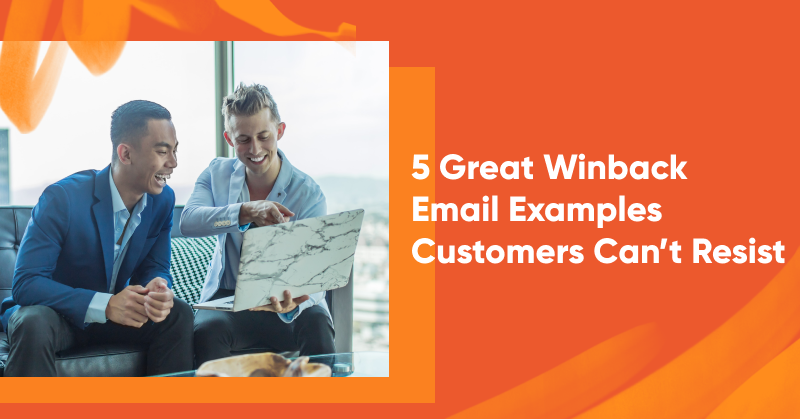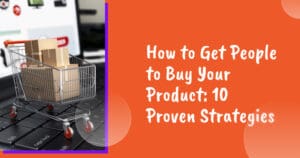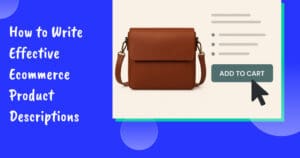Winback emails give any business a vital second chance to recapture the attention and desire of lost customers. An effective win-back email campaign could present a golden opportunity for your business to retain more customers and make more sales…you just need to know what approach to take!
There are many different strategies for sending out win-back emails. Understanding the different strategies is important because you need to make sure you send out the right type of email to match your audience’s interests.
In this guide, we’ll break down five of the best win-back email examples. No matter what you sell, trying out these win-back email campaigns could help you recover lots of lost sales.
What is a win-back email campaign?
A win-back campaign is sent out with the goal of re-engaging inactive contacts on your mailing list. These contacts could include customers who’ve made a purchase and since lost interest, or subscribers who’ve simply stopped opening your emails.
The aim of any win-back email campaign is to get these seemingly “lost” users to start interacting with your emails and clicking on your calls-to-action again.
Remember, it’s a lot more expensive to acquire new customers than it is to win back existing ones, which is why a win-back email sequence is so important!
5 best win-back email examples and strategies
While win-back emails all have the same general goal, there are many different strategies that you can take to achieve this.
Here are a few of the best types of win-back emails, and examples that show them in action.
1. Incentive win-back emails
First up is the classic incentive win-back email. This is a common strategy used by all kinds of businesses to get inactive customers to return. And there’s a reason why so many businesses use this win-back email strategy—because it works.
As the name suggests, this type of email offers subscribers an incentive to return. Lapsed customers won’t just return or make another purchase because you ask them nicely! They need something to give them a little extra nudge.
An incentive win-back campaign offers something special, like a discount code on their next purchase. These emails could also include:
- Free shipping
- A bonus gift
- A free upgrade
- A free consultation
- Anything else that adds extra value
Sending out incentive win-back emails is one of the best ecommerce marketing strategies for any brand.
Who wouldn’t be tempted to click on a link in order to get $20 off? Incentives also create a sense of urgency when you can make them limited-time offers. This is one of the most effective ways to get lapsed customers to return to your store.
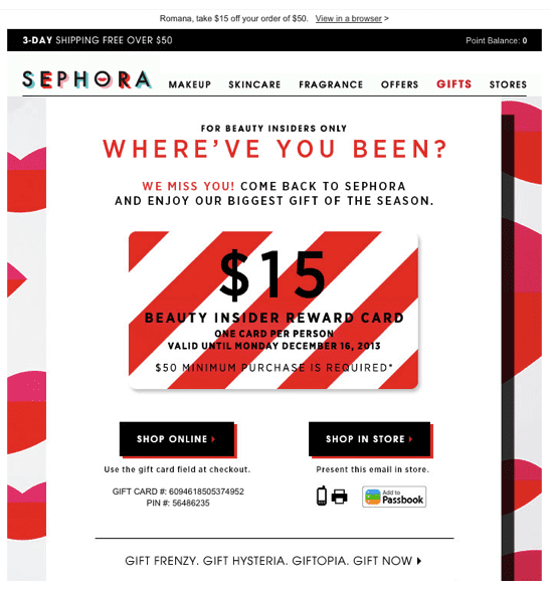
Image source: Smartrmail
2. Hello win-back emails
This is a classic type of win-back email. It’s one of the easiest ways to re-engage your audience, and all it takes is a simple “hello.”
This win-back campaign works by recognizing loyalty and showing customers that you care about them. It makes your customer feel special, and it won’t cost you anything.
This type of win-back email should accomplish the following goals:
- Remind old customers why they decided to support your business initially
- Remind customers of the unique benefits of your best-selling products
- Recognize and appreciate the customer
- Keep your brand at the front of your customer’s mind
Just remember to keep these win-back emails simple. Disengaged customers don’t need a lot of copy or distractions. Sometimes people just forget about your brand, but a simple reminder could bring them back!
Keep it friendly, concise, and focused on making the customer feel special.
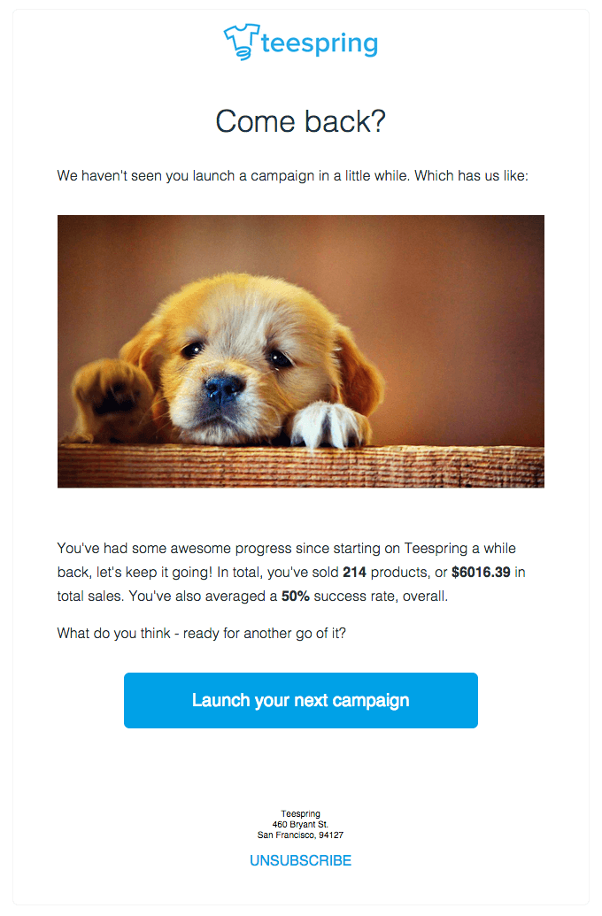
Image source: ActiveCampaign
3. Creative content and copy win-back emails
One of the best things to do with your win-back email campaigns is to show off your creativity. By sending creative content that really grabs the recipient’s attention, you’ll have a good chance at winning the customer back.
You want to remind your readers that your brand is unique, and give them a reason to remember you. So try to do things differently! Think of an email format that stands out from what your competition typically sends, so you can surprise and delight your customers with pure originality.
One of the best strategies for this is to share other creative marketing content, like blog content or videos. These emails are great places to add value and ensure the user takes away something special.
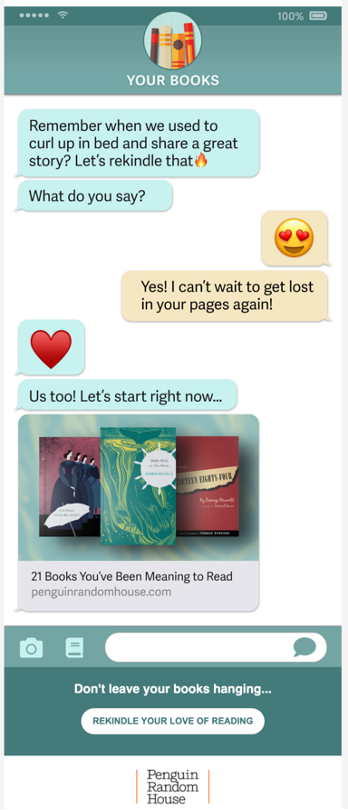
Image source: Klaviyo
4. Feedback win-back emails
Instead of just trying to reel customers back in, feedback emails ask customers why they’ve disengaged with your business. This approach serves two main purposes.
First, feedback emails show customers that their satisfaction is a top priority for your business. This might just be reason enough for them to return.
Second, even if the customer doesn’t want to return, feedback emails can provide valuable, specific insights into how you could improve the overall customer experience. This might involve making changes to your ecommerce shopping experience, offering more flexible shipping options, or providing better customer service.
Plus, people love providing feedback. By sending out these kinds of emails, you’re likely to get much greater engagement rates and lots of useful feedback.
So many customers stop supporting a business due to a bad customer experience. If you’re able to show that you care enough to ask why they’ve lost interest, there’s a good chance you’ll be able to win those customers back and regain their support.
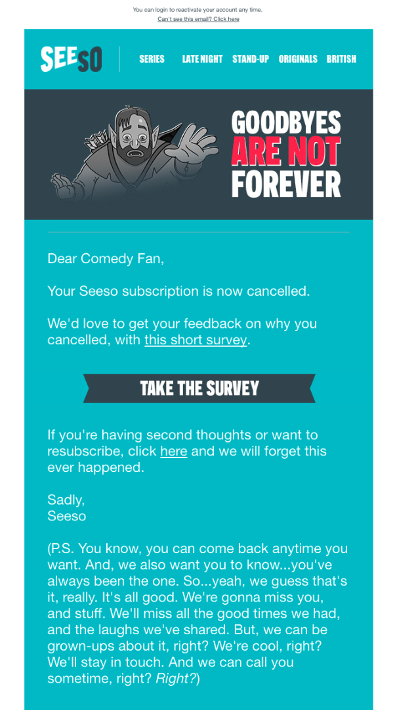
Image source: Reallygoodemails
5. Unsubscribe win-back emails
People unsubscribe from your mailing list all the time. It’s normal, and it doesn’t always mean they won’t be back. In some cases, subscribers just don’t want to receive emails from you at that very moment, or they’re unsubscribing to lots of newsletters to save space in their inbox. Many customers actually end up wanting to rejoin your mailing list after they’ve unsubscribed.
By sending out an unsubscribe email, you’re giving yourself a last chance to recapture those customers’ attention. If anyone is still on the fence right after unsubscribing, your message could get them to opt back in. And if they’re not ready at that moment, they can always come back to it and resubscribe later!
Use your unsubscribe message to offer excellent customer support… the kind of customer experience that the subscriber just can’t afford to lose. Be personal, show that you care, and show that you value the subscriber.
It’s also a good idea to give your customers options in these emails. Maybe they’re not unsubscribing because they don’t like the content you send, but simply because you send too much of it. If you give them the option to receive only your monthly newsletter, they might be interested again.
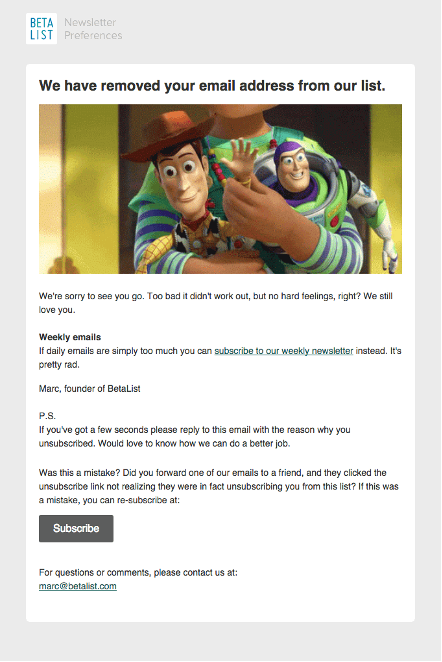
Image source: ActiveCampaign
6 best practices for effective win-back email campaigns
So, you’re inspired to win back those lapsed customers? Awesome!
Let’s dive into some best practices to make sure your winback emails hit the mark:
1. Personalization is key
Nobody likes feeling like just another number in a database. Make your inactive customers feel special by personalizing your winback emails.
Use their name, reference past purchases or interactions, and tailor your message based on their behavior.
Personalization shows that you value their individual relationship with your brand.
2. Timing is everything
Strike while the iron is hot—or in this case, while the memory of your brand is still fresh.
Don’t wait too long to send a win-back email after a customer starts losing interest in your brand.
Aim for a timely approach to catch them before they’ve moved on completely.
3. Offer irresistible incentives
Give your inactive customers a reason to come back. Whether it’s a discount, a freebie, or exclusive access to new products or features, make sure your offer is too good to pass up.
Tailor your incentives based on your understanding of what motivates your customers.
4. Keep it concise and clear
Attention spans are short, so keep your winback emails brief and to the point.
Clearly communicate why you’re reaching out, what you’re offering, and how they can take action. Use clear and compelling language that prompts immediate engagement.
5. Test, learn, and optimize
Don’t just set it and forget it. Test different elements of your win-back emails—subject lines, copy, calls to action, timing—and analyze the results.
Learn from what works (and what doesn’t) to continuously optimize your win-back strategy.
6. Respect their decision
Sometimes, despite your best efforts, a customer may choose not to re-engage with your brand.
Respect their decision and use their feedback to improve your products, services, or communication strategies for future customers.
Don’t limit your win-back campaigns to email
A win-back email campaign can be incredibly effective, but there’s another option you shouldn’t forget about: SMS.
Consider this: your SMS messages will never end up in a spam folder, SMS marketing messages have a far higher open rate, and recipients are typically much more engaged.
We all carry our phones around all day, which means that people check SMS messages much more frequently than emails.
For ecommerce stores, this presents a major opportunity for win-back campaigns. All of the same strategies listed above can be used in SMS win-back messages, just in a more condensed format.
FAQ
Why do subscribers stop opening emails?
Subscribers may stop opening promotional emails for various reasons:
- Email overload: In today’s digital age, inboxes are inundated with messages from various sources. Your emails may get lost in the shuffle, leading to decreased open rates.
- Lack of relevance: If your emails no longer provide value or relevance to subscribers, they may lose interest over time and stop opening them.
- Change in preferences: Subscriber preferences and interests may evolve over time, leading them to disengage from your email communications.
- Technical issues: Sometimes, emails may end up in spam folders or not be delivered at all due to technical issues, causing subscribers to miss them.
When should I send win-back emails?
The timing for sending a win-back email campaign can vary depending on your target audience and industry. However, here are some general guidelines:
- After a period of inactivity: Send win-back emails after a subscriber has been inactive for a certain period, such as 3 to 6 months. This allows you to re-engage them before they completely disengage from your brand.
- Around special occasions: Consider sending win-back emails around special occasions or holidays when customers may be more receptive to offers and promotions.
- Based on behavioral triggers: Trigger win-back emails based on specific behaviors, such as abandoning a cart or not opening emails for a consecutive number of days.
- During off-peak times: Avoid sending win-back emails during peak times when subscribers are likely to be bombarded with emails. Opt for off-peak times to increase the chances of your email standing out.
Remember to test different timing strategies and analyze the results to determine the most effective timing for your win-back email campaigns.
Summary
With the right approach, your win-back emails can result in better customer engagement and more sales. You just need to make sure you use a carefully planned strategy when putting together your campaigns.
The winback email examples above include some of the most tried and tested ways to recover customers and re-engage those who’ve lost interest in your brand.
No matter what you’re selling, try these email strategies out…they’re easy to set up, and they could make the difference between a lost customer and a new sale.
Share this
Written by

Tom Kotze
Tom is a marketing content writer at Wishpond - the all-in-one marketing platform. Tom writes about the latest marketing trends, eCommerce, and entrepreneur stories.
